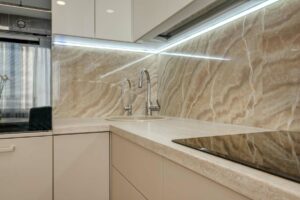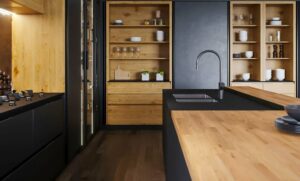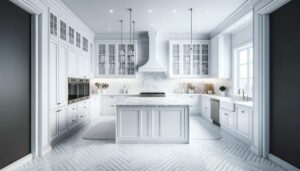Proper kitchen lighting design is extremely important for functionality and creating a space with the right ambiance. The kitchen is often the busiest room of the house and adequate lighting is necessary for cooking, eating, socializing and various other activities.
From general ceiling lights, to task lighting over key work areas, to accent lighting for design, there are several types and placement positions to consider when planning kitchen lighting.
This comprehensive guide provides tips and ideas to illuminate your kitchen perfectly. We discuss the most important factors in kitchen lighting design from choosing the right types and brands of lights, ideal light fixture placement positions, light sources and controls to consider, energy efficiency, professional design advice and lighting tips to visually complement and enhance kitchen features.
Modern Kitchen Lighting Plan
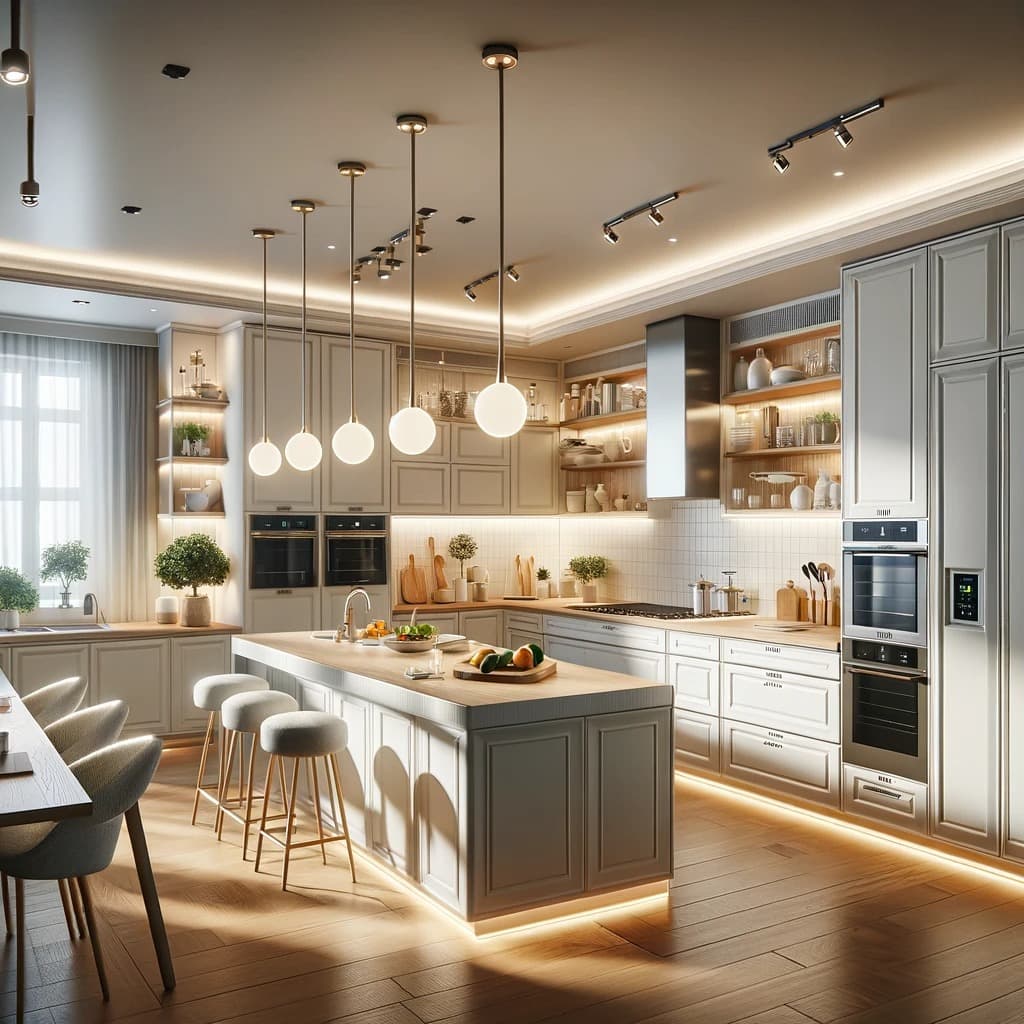
With the right lighting plan, style, accessories and fixtures, your kitchen can not only become more beautiful, but also more user-friendly and safe.
Some key reasons proper kitchen lighting solutions are essential:
- Enables prepping ingredients, cooking and using kitchen safely
- Creates inviting ambiance for entertaining guests
- Makes tasks like reading recipes easier
- Highlights beautiful design elements
- Sets mood with ability to control lighting brightness and direction
- Saves money long-term with efficient lighting
Follow our complete kitchen lighting guide page to learn how to brighten up your cooking space and highlight both form and function with the best kitchen lighting ideas and solutions.
Types of Kitchen Lighting
There are four main types and brands of lighting used in modern kitchen top design:
Ambient/General Lighting
This feature provides overall general illumination throughout the entire kitchen. Ambient lighting is important for navigating safely around the kitchen and is typically achieved with ceiling lights.
- Purpose is to brightly light the entire kitchen
- Usually ceiling lights such as flush mount or pendant lights
- Important for navigating room safely
- Should enable seeing kitchen features clearly
Task Lighting
Task lighting is directional lighting pointed at key work areas in the kitchen where food preparation and cooking occurs.
This full light fixture includes focused lighting over countertops, kitchen islands, stoves and sinks. Task lighting helps eliminate shadows so you can safely use appliances and tools.
- Focused beam lighting key work zones
- Aimed at countertops, islands, stoves
- Helps prevent shadows over prep areas
- Enables seeing small ingredients clearly
Accent Lighting
Accent lighting highlights specific features, surfaces or objects in a kitchen. This includes architectural details like lighting inside glass door cabinets or under cabinets to spotlight decor. Accent lighting adds depth and dimension.
- Spotlights decorative features
- Often used in glass door cabinets, under cabinets
- Track lighting also qualifies as accent lighting
- Creates depth and dimension if focused on design details
Natural Light
Maximizing natural sunlight and air coming into the kitchen through windows and skylights balances out artificial lighting. Combining natural and ambient lighting works best for practicality and visual harmony.
- Sunlight from windows, skylights
- Blends with other lighting for balance
- Saves on electricity usage
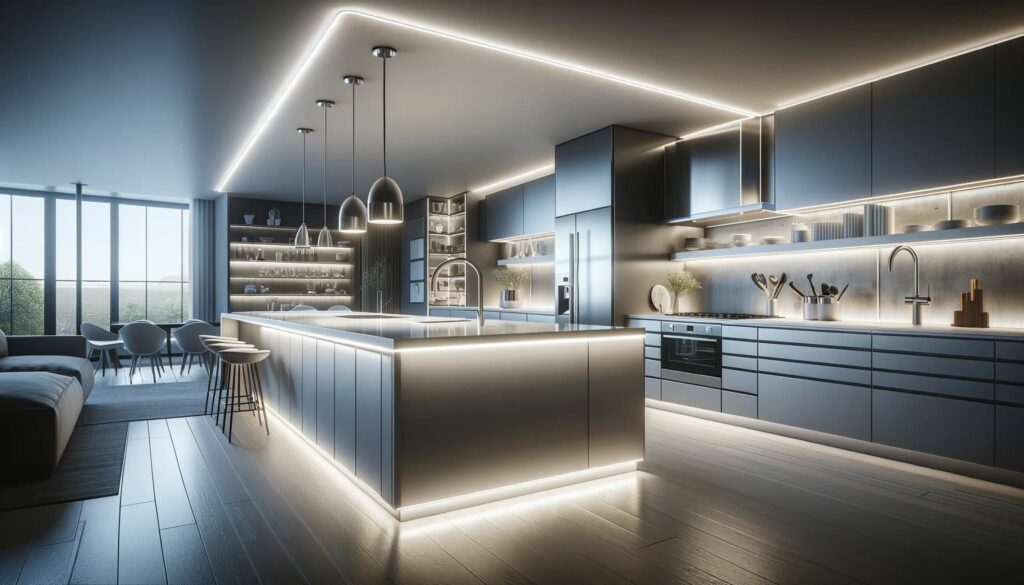
Key Positions for Kitchen Lighting
Where you place lighting fixtures in the kitchen makes a significant difference in meeting both practical and aesthetic needs.
Ceiling Lights
Ceiling mounted lighting serves as the general ambient lighting fixture for the entire kitchen. Flush mount or pendant lights centered over the counters and key areas help illuminate activity zones:
- Main source of ambient lighting
- Centered over sink, stove, dining table
- Helps navigate overall kitchen
- Flush mount or pendant lights typical
Under Cabinet Lighting
Under cabinet lighting provides close-up task lighting over countertops and important work zones where meal preparation occurs. This light eliminates shadows on counters, so you can safely chop, cook and use kitchen tools.
- Mounted under wall cabinets on top of countertops
- Shines down to illuminate counter space directly
- Prevents shadows over cutting boards, appliances
- LED strip lighting common choice
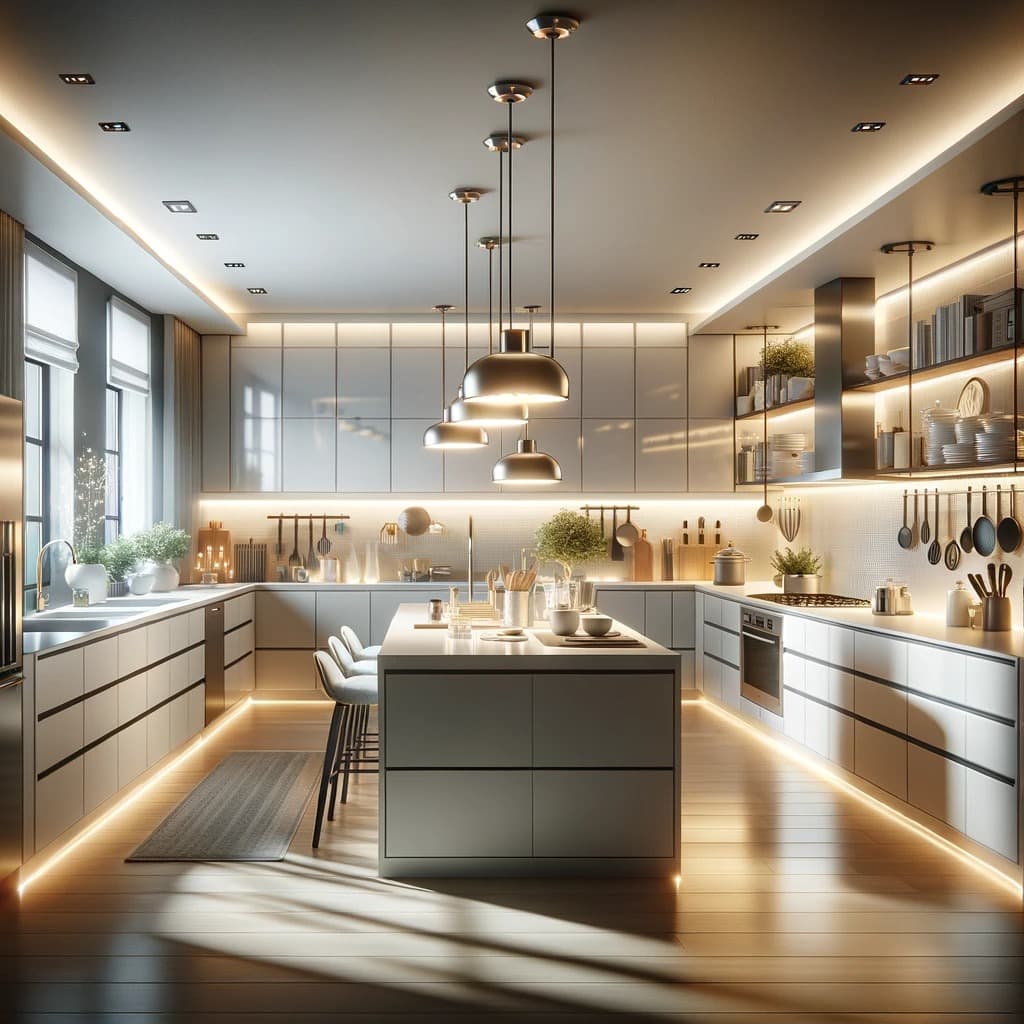
Over Cabinet Lighting
While not as common as ceiling or under cabinet lights, some kitchens use recessed or surface mounted lights that hang directly above the cabinets for ambient lighting. This can provide an alternative to harsh overheard lighting.
- Recessed or surface mounted over cabinets
- Serves as ambient lighting for room
- Less harsh than overhead lights
- Optional choice, less typical
Choosing Light Sources
An important kitchen lighting decision is selecting the right bulbs and fixtures optimized for brightness, efficiency, colors, shapes and controls.
Fluorescent vs LED vs Incandescent
There are pros and cons to common kitchen lighting fixture choice:
| Type | Pros | Cons |
|---|---|---|
| LED | Energy efficient. Very long lifespan – no frequent replacement needed. Dimmable. Wide variety of color temps. | Higher upfront cost. Sensitive to heat. |
| Fluorescent | Efficient. Lower cost. Bright light. Long lifespan. | Contains mercury. Buzzing noise. Poor dimming ability. Cool light temps. |
| Incandescent | Familiar warm light. Works with dimmers. Inexpensive. | Very inefficient – 90% of energy wasted as heat. Short lifespan. |
LED lights are the most popular choice today given energy efficiency, flexible color temperatures, and longevity. Fluorescent lights require replacement more often and incandescent bulbs are notoriously energy wasting.
Color Temperature
The color tint of light bulbs is measured in degrees of kelvin and commonly comes in warm, cool or neutral shades:
- Warm white – (2700K-3000K) – Best for coziness
- Cool white – (3500K-4100K) – Simulates daylight
- Soft white – (3000K-3500K) – compromise between warm and cool
Choose color temperature depending on your decor, style, kitchen size, and desired aesthetic. Smaller kitchens often suit warm white for a cozier effect.
Additional Considerations
Beyond understanding the core lighting types and positions, here are some other kitchen lighting factors to address:
Lighting Controls
Installing lighting controls like dimmers, motion sensors and remote controls allows you to easily adjust the brightness and ambiance in the kitchen when needed:
- Dimmer switches enable adjustable brightness
- Motion sensors turn lights on/off when detecting movement
- Remote controls provide convenience for hard-to-reach lights
- Smart light controls take automation further tying into an overall home automation system
Kitchen Lighting Plan
Hiring a professional lighting designer can be invaluable to plan and install a modern kitchen lighting layout optimized for your family’s needs and kitchen dimensions and features.
- Professional lighting plan factors in layout, ceiling height, activity zones
- Expert planning prevents under or over lighting any spaces
- Well-designed lighting layout feels cohesive
Energy Efficiency Considerations
Choosing ENERGY STAR certified LED bulbs, utilizing natural light from windows, and installing automatic controls helps maximize energy efficiency.
- ENERGY STAR labels indicate most efficient options
- Strategic use of natural light reduces energy consumption
- Automatic controls turn lights off when not needed

